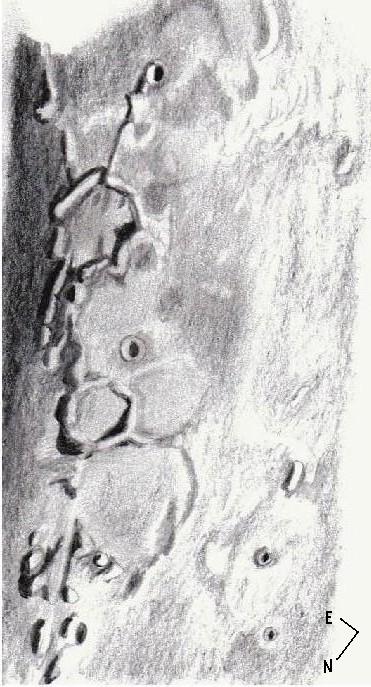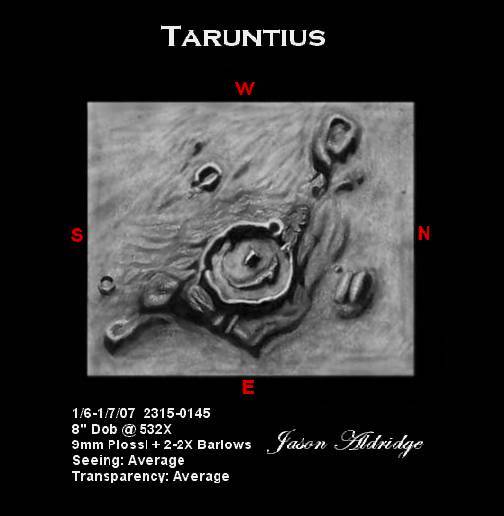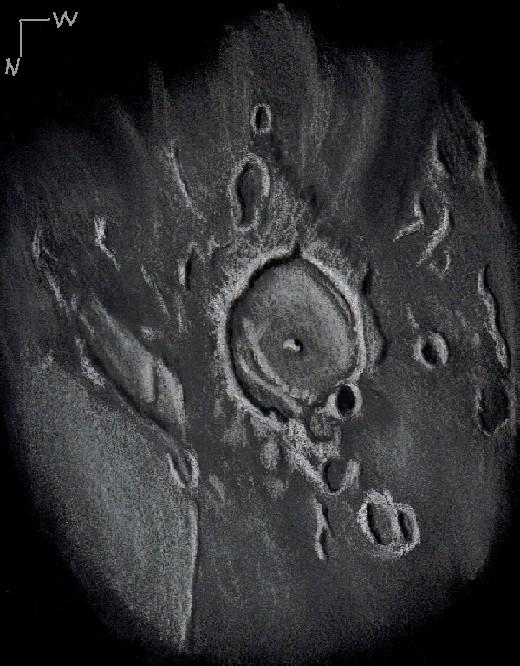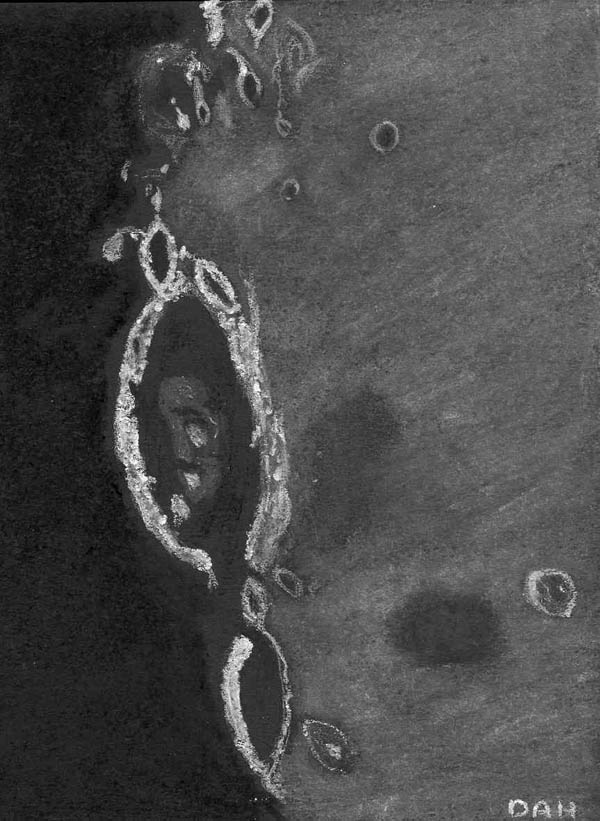On a frosty early morning in the fall of 2006, just a couple of days past third
quarter moon, I selected for sketching a famous old battered region between Mare
Nubium and Mare Cognitum. This region includes four large craters that were
damaged by low flying Imbrium ejecta that caused them to look old and battered
before their time. Nearest the terminator to the north is crater Guericke (59km)
with its flat lava flooded floor that opens to Mare Nubium. Crater Parry, smaller
at 49 km in diameter is older and also flat floored. The other two craters which
look ghostly in the sketch are larger and older and share common walls with Parry.
These craters are Bonpland (61 km.) to the west and Fra Mauro (96 km.) to the
north of Parry. The wall of Parry encroaches on Bonpland and both together on to
Fra Mauro to betray the cratering sequence of these three.
Sketching:
For this sketch I used: copy paper 8.5”x11”, #2HB graphite pencil,
Pink pearl eraser.
Telescope: 6 inch f/ 7.9 Dobsonian at 208x ( first light for this scope)
Date: 10-15-2006 10:30-11:15 UT
Temperature: 0° C (32° F)
Clear, calm
Seeing: Antoniadi III
Co longitude: 190 °
Lunation: 23 days
Illumination: 36 %
Frank McCabe
Category: crater
Clarity brought to complexity
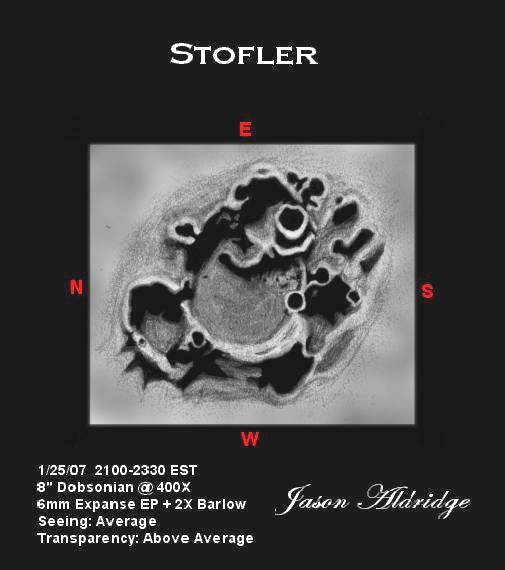
This is my impression of the Lunar Formation Stofler. It was sketched with a #2HB
0.5mm mechanical pencil on Strathmore Wind Power Sketching Paper. Other pertinent
details are on the sketch itself. I found this lunar feature to be one of the most
interesting that I have seen. It appeared to me, that this piece of lunar real
estate was painted with a giant bulls eye.
Jason Aldridge
Repsold on the rim
A favourable lunar libration put the crater Repsold at a better
perspective than what one usually finds. And finding it on the
terminator made it an object for a quick sketch despite the obstacles.
It was only a few days before a June full moon so the moon was quite low
(from 50 degrees north lat.) even when near the meridian. Turbulence
and generally poor seeing kept things from looking sharp for more than
brief instants. And the mosquitoes were bad enough that at times they
cast long shadows across my sketching paper. Sketch done using
graphite pencils, ink and some not entirely successfull applications of
whiteout. I usually like to take longer with a sketch but the
mosquitoes kept the viewing short. North is more or less up and east is
to the left. Viewed through 150mm f/6 Maksutov Newtonian with
binoviewer, 2x barlow and 23mm eyepieces.
Repsold is a rather large crater at approximately 110 kms diameter that
is known for a prominant rille of the same name that runs through it.
Some of the unusual highpoints in the sunlight of my sketch might be
part of that formation as they are oriented in an agreeable direction.
But being unfamiliar with that extreme limb crater, I cannot say for
certain. Sketching limb craters present its own unique challenges and I
find myself thinking more of the three-dimensionality of the crater as
you are no just ‘looking down’ onto the third dimension.
Gerry Smerchanski
Gassendi Sunrise
As the 11 day old waxing gibbous moon approached the meridian, I was able to easily search the terminator in a standing position at the eyepiece to find a suitable sketching target. Target located, I began my sketch near the end of evening twilight. The 110 km. diameter floor fractured crater Gassendi was right on the terminator. The central peak was just touched by morning sunlight as were the tallest portions of the western rim across the blackness of the chasmic floor. The unilluminated portion of the south rim is tilted and facing the center of Mare Humorum. This large 3.7 billion year old crater has on its rim to the north a 33 km. crater known as Gassendi A which is mimicking the rim illumination of the former save the central peak. A small portion of the eastern wall of Gassendi B (26 km.) was also visible north and west of A.
Sketching:
For this sketch I used: black Strathmore 400 Artagain paper, white and black Conte’ pastel pencils and a blending stump. Brightness was slightly decreased after scanning.
Telescope: 10 inch f/ 5.7 Dobsonian and 6mm eyepiece 241x Date: 6-26-2007 2:15-3:10 UT
Temperature: 26° C (78° F)
Hazy, 88% humidity
Seeing: Antoniadi II- III
Colongitude: 40.2 °
Lunation: 10.96 days
Illumination: 81.3 %Frank McCabe
Even craters have their faults
Here is my impression of the Lunar Crater Taruntius. It was sketched with a #2HB
0.5mm mechanical pencil on Strathmore Wind power Sketching Paper. Other pertinent
details are on the sketch itself. What caught my eye with this particular lunar
feature was the ring of hills wrapping around the central peak.
Jason Aldridge
Florida, USA
Fractured floor and a rim shot
Crater Taruntius with Cameron on its Rim
Between southern Mare Tranquillitatius and northwestern Mare Fecundatatius lies the Copernican period crater Taruntius (57 km). This crater was some distance from the terminator but with surrounding smaller craters showing deep shadows, it is clear that Taruntius is a shallow crater. Note the deep shadow in Cameron (12 km) on the northwest rim of Taruntius. In addition to Cameron other rim features include breaches to the north and south along the rim and interesting rough ramparts to the lava floor beyond the crater especially southward. This floor fractured crater presents a small central peak surrounded by dark ash deposits from volcanic activity on the crater floor.
Sketching:
For this sketch I used: black Strathmore 400 Artagain paper, white and black Conte’
pastel pencils and a blending stump. Brightness was slightly decreased after scanning.
Telescope: 10 inch f/ 5.7 Dobsonian and 6 eyepiece 241x
Date: 6-20-2007 1:15-1:50 UT
Temperature: 21° C (70° F)
Clear, calm
Seeing: Antoniadi III
Colongitude: 326.2 °
Lunation: 4.9 days
Illumination: 26.6 %
Frank McCabe
Two great philosophers meet on the Moon
Aristoteles and Eudoxus
Warm moist air from the south and cool dryer air from the north have been battling it out over the Chicago area for the last week. This morning the cold air was winning as the thermometer in my yard was reading 47°F. Fortunately the cold high pressure air mass was accompanied by better than average seeing and transparency.
The 20 day old waning gibbous moon was about 30° above the southern horizon at an hour and a half before sunrise. For sketching targets I chose Aristoteles and Eudoxus along the northern terminator. The view in my 10” f/5.7 Newtonian held up well at both 241X and 362X. I sketched at the eyepiece using both magnifications. Twin peaks on the floor of Aristotles were visible with the southeastern most peak surrounded by shadow. This 90 km Eratosthenian crater was displaying nicely terraced wall on the steep eastern side. Off to the terminator side (east) and overlapped by Aristoteles is the shadowed floor crater Mitchell (31 km.) an older Imbrian formation. Further north along the terminator margin is rim illuminated crater Galle which stretches 22 km in diameter and is about the same age as Aristoteles. The other large and younger crater to the south is Eudoxus (70 km.) which also has steep terraced walls. A small part of the Caucasus mountain range can be seen west and southwest of Eudoxus. Due west of Aristoteles the ancient eroded ghost-like crater Egede at 37 km in diameter can be seen in contrast to the younger craters named above.
Sketching:
For this sketch I used: black Strathmore 400 Artagain paper, white and black Conte’ pastel pencils and a blending stump. Brightness was slightly decreased after scanning.
Telescope: 10 inch f/ 5.7 Dobsonian and 6 and 4 mm eyepiece 241 and 362X
Date: 6-6-2007 9:05-10:00 UT
Temperature: 8° C (47° F)
Clear, calm
Seeing: Antoniadi II-III
Colongitude: 158.7 °
Lunation: 20.6 days
Illumination: 72.7 %
Frank McCabe
On the shores of a Stormy Ocean
Hevelius & neighbours
Sketched on the 29th May 2007 from my home observatory using a Antares 105mm F15
Achromatic refractor. Working at 163x through a Denk binoviewer.
Sketch made on a black spiral bound Daler-Rowney 6″x6″ sketch pad using a
combination of Conte sticks, watercolour and pastel pencils. Image scanned in
Greyscale but unprocessed.
Dale Holt
Mighty Copernicus
My second (and last) crater so far. Not the most easy to draw, but he was asking for
it. Drawing the moon is a lot more difficult than expected. There are so many
features to pay attention to. I had to stop sketching after an hour, because the
shadows were changing the view.
The image is flipped to match a North down view.
Date : June, 05, 2006
Time : 21.10 UT
Seeing : 2
Scope : ETX 105
EP : Vixen zoom with barlow.
Power : x240
Rony De Laet
http://www.geocities.com/rodelaet, my personal website.
View from a high point
Walled Plain Craters Hipparchus and Albateginius
Close to the visible center of the lunar nearside are the north-south crater pair
Hipparchus and Albateginius. On this evening from my observing site they were on
the sunrise terminator. Hipparchus at 150 km. in diameter is the largest and
oldest of the pair dating from the pre-Nectarian period (4 billion years ago). At
and internal to the northeast rim of Hipparchus lies crater Horrocks (30 km.) with
its bright rim and the deep dark center.
Just beyond the Hipparchus crater rim to the southeast is the young, small (15
km.) crater Pickering also with a well illuminated rim. Near the center of
Hipparchus crater Hipparchus X is visible and between it and Horrocks a small
narrow rille was easily seen which is parallel to Rima Reaumur lying out beyond
the Hipparchus rim to the northwest (not sketched). Between Hipparchus and
Albateginius are the old craters Halley (37 km.) and Hind (31 km.). Most of the
rim of crater Albateginius (139 km.) is brightly illuminated by the sun as are two
high points within the “well of darkness”. The illuminated point closest to the
center is the top of a central peak. The other bright point closer to the rim is
the high point on the margin of crater Klein (44km) sitting in darkness. At the
beginning of the sketch these two points were not visible but appeared about 45
minutes after I started.
I tried to picture in my mind what the view would be like if you could stand on
either of these high points and look out and down. Wouldn’t that be a sight?
Sketching:
For this sketch I used: black Strathmore 400 Artagain paper, white and black Conte’
pastel pencils and a blending stump. Contrast was slightly increased after scanning.
Telescope: 10 inch f/ 5.7 Dobsonian and 6 mm eyepiece 241X
Date: 5-24-2007 2:05-3:20 UT
Temperature: 23° C (74° F)
Partly cloudy with haze, light winds
Seeing: Antoniadi II
Colongitude 356.7 °
Lunation 7.28 days
Illumination 52 %
Frank McCabe

